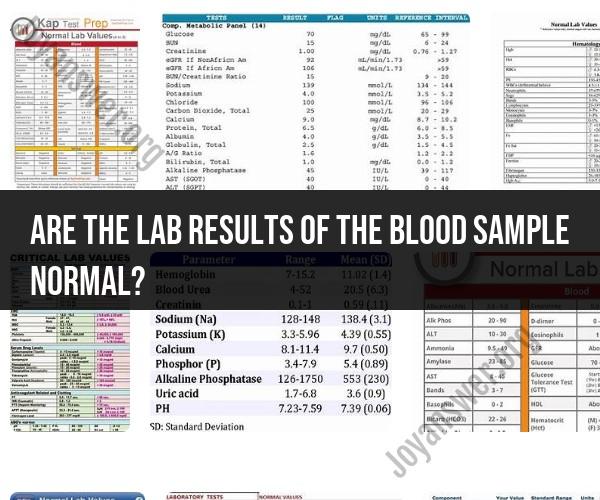Are the lab results of the blood sample normal?
Understanding Normal vs. Abnormal Lab Results
When you receive the lab results of a blood sample, it's essential to understand the difference between normal and abnormal values. These results provide crucial insights into your health status and can help identify potential medical issues.
Normal Lab Results
Normal lab results indicate that your blood values fall within the typical or healthy range for the specific test. Normal values can vary depending on factors such as age, gender, and the specific laboratory that conducted the test. If your results are within the normal range, it generally means that your health is within the expected parameters for that particular measurement.
Abnormal Lab Results
Abnormal lab results, on the other hand, suggest that your blood values deviate from the expected or healthy range. Abnormal results can be an indication of an underlying medical condition or problem that may require further evaluation, diagnosis, or treatment. It's important not to panic if you receive abnormal results, as they may be due to various factors and may need additional testing to determine their significance.
Consulting a Healthcare Professional
If you receive lab results and are unsure about their implications, it's crucial to consult with a healthcare professional, such as your doctor or a medical specialist. They have the expertise to interpret the results in the context of your overall health, medical history, and specific circumstances. They can provide guidance on any necessary follow-up actions, such as additional tests or treatments.
Conclusion
Understanding and interpreting lab results from a blood sample is a critical step in managing your health. Normal results provide reassurance, while abnormal results may prompt further investigation. Always rely on the expertise of healthcare professionals to interpret your lab results accurately and guide you toward the most appropriate actions for your well-being.
Interpreting Blood Sample Lab Results: What's Normal?
Blood test results are compared to a reference range, which is a set of values that are considered normal for most people. The reference range for a particular blood test can vary depending on your age, sex, and other factors.
If your blood test results are outside of the reference range, it doesn't necessarily mean that you have a medical condition. However, it is important to talk to your doctor about your results so that they can determine if any further testing or treatment is needed.
Here are some of the most common blood tests and their normal ranges:
- Red blood cell count (RBC): 4.2 to 5.4 million cells/μL for men and 3.8 to 5.0 million cells/μL for women.
- White blood cell count (WBC): 4,500 to 11,000 cells/μL.
- Platelet count: 150,000 to 400,000 platelets/μL.
- Hemoglobin: 13.5 to 18.0 grams/dL for men and 12.0 to 16.0 grams/dL for women.
- Hematocrit: 40.7 to 50.3% for men and 36.1 to 48.0% for women.
- Cholesterol: Total cholesterol should be less than 200 milligrams/dL (mg/dL). LDL (bad) cholesterol should be less than 100 mg/dL. HDL (good) cholesterol should be 60 mg/dL or higher.
- Blood sugar: Fasting blood sugar should be less than 100 mg/dL. Two hours after eating, blood sugar should be less than 140 mg/dL.
Analyzing Blood Test Results: What to Look For
When analyzing blood test results, your doctor will look for patterns and trends. For example, if your cholesterol levels have been rising over time, your doctor may be concerned that you are at risk for developing heart disease.
Your doctor will also consider your individual medical history and risk factors. For example, if you have a family history of heart disease, your doctor may be more concerned about high cholesterol levels than someone who does not have a family history of heart disease.
Understanding Blood Work: Normal Ranges and Abnormalities
It is important to understand the normal ranges for blood tests and what abnormalities can mean. This can help you to make sense of your blood test results and ask informed questions of your doctor.
Some common abnormalities in blood work include:
- High red blood cell count: This can be caused by dehydration, smoking, or certain medical conditions such as heart disease or lung disease.
- Low red blood cell count: This can be caused by anemia, which can be caused by a variety of factors, such as iron deficiency, vitamin B12 deficiency, or blood loss.
- High white blood cell count: This can be a sign of infection, inflammation, or certain types of cancer.
- Low white blood cell count: This can be caused by certain medications, autoimmune diseases, or viral infections.
- High platelet count: This can increase the risk of blood clots.
- Low platelet count: This can increase the risk of bleeding.
- High hemoglobin or hematocrit levels: This can be caused by dehydration, smoking, or certain medical conditions such as heart disease or lung disease.
- Low hemoglobin or hematocrit levels: This can be a sign of anemia.
- High cholesterol levels: This can increase the risk of heart disease and stroke.
- High blood sugar levels: This can be a sign of diabetes or prediabetes.
- Low blood sugar levels: This can be caused by certain medications, diabetes, or other medical conditions.
If you have any questions about your blood test results, be sure to talk to your doctor. They can help you to understand what the results mean and what steps you may need to take to improve your health.













